
JANE BURN – POETRY AS HARD GRAFT, INSPIRATION, REACTION OR EXPERIMENT?
I interviewed poet & artist Jane Burn who won the Michael Marks Environmental Poet of the Year 2023-24 with A Thousand Miles from the Sea.
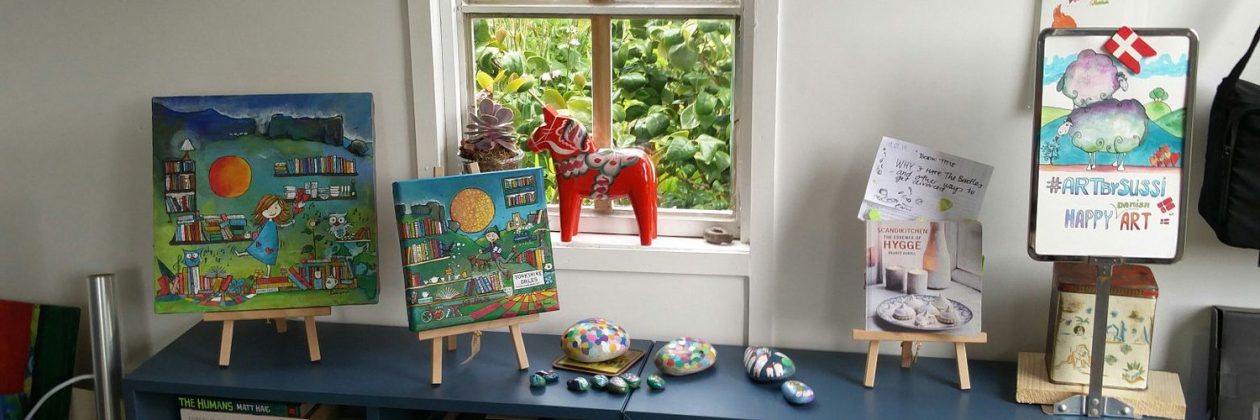
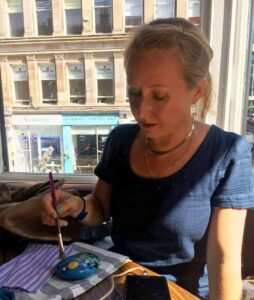
I interviewed Sussi Louise Smith who describes herself as a, ‘Danish artist & poet living in Ilkley, UK, painting life in colourful naivism’. Sussi talked about how she creates her art and what she draws from Danish ideas such as Livsmalerier and Hygge. She also talks about Danish artists, world artists, and compares Denmark to England.
Leslie: Tell us about your art and livsmalerier.
Sussi: Livsmalerier is a combination of two Danish words meaning Life and Paintings. I chose to put the two together, firstly because if we run out of words in Danish we just make new ones up by combining other ones, and secondly because that is what I do. I paint life. Not necessarily how it really is in this particular time and space, but as it was, could or should be according to the viewpoint or person I am interviewing. I paint the intricacies and small details that make a difference to us. Or as Gregory Bateson said in his book ‘Steps to an Ecology of Mind‘: The difference that makes a difference.
So when I paint a livsmaleri for a person, I ask them, or the people who ordered the painting, what has made a difference in the subject’s life story. What makes them happy, how they dress, what music they listen to, what is their favourite place in their home and in the world? What has made a difference to them in their life, and who – family, friends, dogs, cars, bicycles, houses they have loved, places they have visited. All the stuff that makes a person who they are. That is what I love. The life history aspect of storytelling. There is always more than meets the eyes to us all.
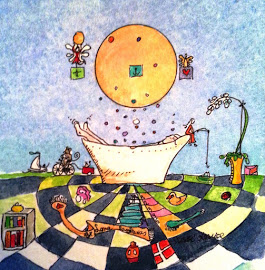 I paint mostly in watercolours and inks, but I also paint on canvasses, wood and stones. To be honest I will paint on anything, but there are laws against that! I was only in my teens when I had my first little exhibition and back then I did a lot of pencil drawings and oil pastels. I still do those sometimes, but I just love the presence of water in my art. I am a daughter of the sea, and now, living inland for the first time in my life, I find that I miss the sea and open waters so much my heart is aching. Painting helps me so much with that, splashing colours about, then concentrating on the details. Whether we are talking about my naïvistic art or my abstract, it’s always full of colours. When I was young, I found out that I saw so-called reality slightly differently to my siblings and everyone else. One main difference is that I see life in colours – energies, feelings, sentiments, they all have colours.
I paint mostly in watercolours and inks, but I also paint on canvasses, wood and stones. To be honest I will paint on anything, but there are laws against that! I was only in my teens when I had my first little exhibition and back then I did a lot of pencil drawings and oil pastels. I still do those sometimes, but I just love the presence of water in my art. I am a daughter of the sea, and now, living inland for the first time in my life, I find that I miss the sea and open waters so much my heart is aching. Painting helps me so much with that, splashing colours about, then concentrating on the details. Whether we are talking about my naïvistic art or my abstract, it’s always full of colours. When I was young, I found out that I saw so-called reality slightly differently to my siblings and everyone else. One main difference is that I see life in colours – energies, feelings, sentiments, they all have colours.
Leslie: Where, when and how do you get ideas as an artist?
Sussi: It is so easy to just say ‘From Everywhere’ isn’t it. But if I have to explain it it is a bit like this. I may be thinking about cooking, shopping, or a book I am reading or just sat in my morning meditation trying to clear my mind and BAM comes in a motif or a whole design for a person, or just for a painting that wants to join me… just like that. I can’t force it. It comes to me when it is good and ready. So when you ask where, it really can be everywhere. I have been known to get up at 3am to sketch a painting or to pull over the car. I even asked a doctor once to hold it for a sec, ha ha ha. I am very blessed. I do not seem to run out of ideas. Admittedly I have some motifs that return to me all the time, like lighthouses, the sea, bathtubs and ladybirds; bicycles, books, giraffes and music. But more often that not when I paint things just happen. Not unlike when I write. I start with what I think is an awesome plan, then my subconscious goes ‘Nah, lets go THIS way’….
Leslie: When you create artworks what technical approaches do you use, and what unusual/personal approaches do you use?
Sussi: OK, so I have no formal degree. I have been attending painting schools and art classes since I was a teenager and I still very occasionally join a course if there is something I feel I need to learn or brush up on. Looking back, before I’d even started school I spent time with the Danish artist Asger Bohse in his studio. He taught me to mix colours and to work with a spatula on wood. I was so lucky as a child that my mother was a gifted artist who surrounded herself with people like her, and they were kind enough to let me join in from an early age. They taught me all sorts from using beeswax on wood and canvas and hair in oil paints and acrylics, to how to mix the best watercolours with teabags and dandelion root. Cutting up paper and glass, melting candles and plastics, and welding iron. you name it… I still use most of those techniques, apart from the welding,
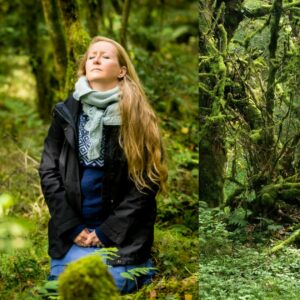 It’s quirky of course, which might be because I meditate a lot and listen to what I ‘hear’ in those moments, or maybe it’s because I have a touch of synaesthesia. Colours have sounds, so often when I paint, I am actually composing a piece. If I listen to music that will affect the colours I choose, so I tend to not do that if it is for a specific person. Then I need to listen to their colours, not necessarily be inspired by Mozart or Hozier.
It’s quirky of course, which might be because I meditate a lot and listen to what I ‘hear’ in those moments, or maybe it’s because I have a touch of synaesthesia. Colours have sounds, so often when I paint, I am actually composing a piece. If I listen to music that will affect the colours I choose, so I tend to not do that if it is for a specific person. Then I need to listen to their colours, not necessarily be inspired by Mozart or Hozier.
Leslie: Who are the artists you admire and what have you learned from them?
Sussi: The first and most influential artist in my life was my mother. I did not always like the style or colour choices she made, but she was absolutely brilliant. There was nothing she would not try. She absolutely adored working in wool and felting. She did massive woollen paintings, some with stitching, some just felted. She would dye her own colours, some from things she found in nature and at one point we had more than 20 angora rabbits that she would use the wool from. Not just for felting but for designing clothes and bags.
I also have a great love for the impressionists, not just the French ones but also for the Guldaldermalerne group in Skagen, Denmark, including Anna Ancher. She like me, saw the beauty in everyday life and would paint scenes from their home and lives – brilliantly, much better than I can do.
There are quite a few living artists that inspire me all the time. The one that springs to mind first is Tjasa Owens. She is a seascape painter from San Francisco, CA. To me her paintings sound like happiness, searching, hope, longing and lostness (is that a word?). Most of all, when I see her art I can smell the sea I miss so much and I can hear the waves brushing against my bare legs on an evening walk by the salty seas at home in Denmark. Amazing. Also, she is just about the kindest most wonderful person you could ever find.
The second one I have to mention is the Danish artist Anne Kristine Lerstrup. She is not very well known, but some of her work makes me feel happy, seen and taught a lesson. Which is also how I feel when I see Ray Mutimer, an absolutely stunning artist and illustrator, probably most known for his work on Postman Pat. Ray can paint ANYTHING with a sense of humour and with a precision I can never achieve. I am lucky to have him as my mentor. The last person I will mention is the illustrator and philosopher Charlie Mackesy, for me, the best illustrator out there at the moment. His ink drawings go straight to my heart. I recommend you buy his book ‘The boy, the Mole, the fox and the horse’. You won’t regret it.
Leslie Can you tell us about Hygge and how you personally practice it, please?
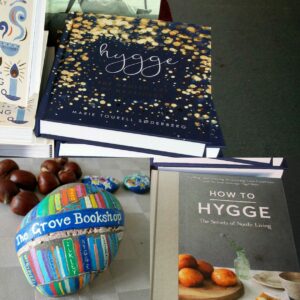 Sussi: Hygge is basically finding the joy and beauty in everyday life. It is about spending time together outside, working in the gardens, going for long walks, then coming home and cooking a meal together. Not a ten veg master-chef thing, maybe just a stew that we put on before going out, or a load of potatoes with a sauce of some kind. Something that is easy, that we can do together and that doesn’t take time away from the social experience. You could say that Hygge is about doing less and being present in the moment. It is also about total honesty and a sense of belonging. Tolerance within the group, but also about not rocking the boat at certain times. In that sense Hygge is more exclusive than inclusive. One can’t just invite oneself for Hygge. One gets invited in. or not. So it’s not all roses.
Sussi: Hygge is basically finding the joy and beauty in everyday life. It is about spending time together outside, working in the gardens, going for long walks, then coming home and cooking a meal together. Not a ten veg master-chef thing, maybe just a stew that we put on before going out, or a load of potatoes with a sauce of some kind. Something that is easy, that we can do together and that doesn’t take time away from the social experience. You could say that Hygge is about doing less and being present in the moment. It is also about total honesty and a sense of belonging. Tolerance within the group, but also about not rocking the boat at certain times. In that sense Hygge is more exclusive than inclusive. One can’t just invite oneself for Hygge. One gets invited in. or not. So it’s not all roses.
I practice it by having a network of a few completely trusted friends. We cook together, share, take care of each other, we are in touch almost every day even if just by text. I switch of my phone when were are doing Hygge, and we have loads of normal candles, an open fire, and we often sit at either end of sofas reading books or next to each other painting, no words spoken. The silence of true belonging. I also practice a bit of the old radical honesty, as we often do in Denmark, although… I am unlearning that skill super quick here in England, where it’s not as appreciated…
I am also a lover of details and the small beautiful things in everyday life. Sun peeping under the clouds at dawn, the dew on the lawn, first snow on the moors, a cup of coffee in my favourite chair, rereading my favourite books, the crunch of an apple, the voice of a loved one, the colour of a beech leaf, meeting beautiful souls in all sizes and shapes and honouring their love and passion for the arts, and nature, and most of all, walking by the sea. Picking up a stone and hearing it still vibrating from the roll of the waves.
Leslie: What would you say are the main differences between Danish and English culture?
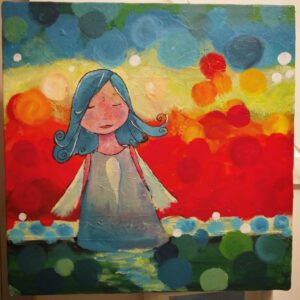 Sussi: Well. You are so polite. at least in most places. Perhaps not in Leeds on a Saturday night or Tesco at 6pm, but generally you really are. Danes have a different sense of politeness. For example, a Danish person says, ‘let’s meet for coffee’… that person will call you and arrange a date. An English person who says that probably just wanted you to get out of their hair. Another example: I once went down to town to run a few errands. I spoke to a total of eight people, some of them for more than five minutes each, and when I got home it was dark and I saw myself reflected in the window. I had a big blue streak of paint on my forehead down the side of my face. and no one had told me. That would never have happened in Denmark, where someone would say, ‘ Yo smurff, don’t you look in the mirror before going out ha ha ha?’ Also your cake baking skills are through the roof!!!! and Tea brewing! On the other hand, no one makes better coffee than the Danes. English society is also really good at clubs and cliques. I have some liking for clubs, but detest cliques.
Sussi: Well. You are so polite. at least in most places. Perhaps not in Leeds on a Saturday night or Tesco at 6pm, but generally you really are. Danes have a different sense of politeness. For example, a Danish person says, ‘let’s meet for coffee’… that person will call you and arrange a date. An English person who says that probably just wanted you to get out of their hair. Another example: I once went down to town to run a few errands. I spoke to a total of eight people, some of them for more than five minutes each, and when I got home it was dark and I saw myself reflected in the window. I had a big blue streak of paint on my forehead down the side of my face. and no one had told me. That would never have happened in Denmark, where someone would say, ‘ Yo smurff, don’t you look in the mirror before going out ha ha ha?’ Also your cake baking skills are through the roof!!!! and Tea brewing! On the other hand, no one makes better coffee than the Danes. English society is also really good at clubs and cliques. I have some liking for clubs, but detest cliques.
Leslie: Tell me about how health issues affect your creative life.
Sussi: I got diagnosed with A. Spondylitis when I was 24 which is an autoimmune disorder, belonging to the family of rheumatoid arthritis. It means my spine often gets inflamed and extremely painful especially in my neck and lower back. This can make painting sitting down very difficult and I can only do it a few hours at a time. It also means I have to do a whole heap of exercises every day to keep my spine as straight and strong as possible, and I follow an incredibly restrictive anti-inflammatory diet. The most effective means I have to manage the rigidity in my spine and the pain, are meditation (I’m a big fan of vibrational meditation) and vagus nerve stimulation. One of the ways to stimulate the vagus nerve is to do things you really love… And since making love 24/7 is a bit much to ask of any partner 🙂 painting and cooking are go-to activities. Painting literally lowers my pain levels.
Leslie: What has been your experience of living with cancer in the family?
Sussi: I am very fortunate not to have had cancer myself, but in my family most people have had it. That includes my husband, so I have lived with cancer very close to me all my life. Breast cancer especially is a tendency in my family. My sister, luckily, is five years out of treatment now and doing well. Mum is no longer here. Dad died of bladder and prostate cancer. My Husband has a rare form of Leukemia.
What have I gained from having cancer so close to me? Well, I do NOT sweat the small things anymore. Some days, when my husband is unwell, we spend a whole day just snoozing and watching railway programmes or whatever is on TV, and that is happiness. You never know when pleasure may be gone, and honestly, I rather be here, than anywhere else. So, love, Hygge and appreciation of the present.
What have I lost? A lot of people I love dearly. Opportunities that were physically impossible because I was caring for someone dying. Time. Time with the people I love.

Leslie: Can you expand, please, on how you came to love giraffes and what effects you’re trying to achieve when you paint them.
Sussi: It is a funny story, how I came to love giraffes. My favourite animal used to be a hippo, but there is a Danish expression Kom og se giraffen. It translates to come and see the giraffe, but really it means come and see the new ‘insert something’ – boss, photocopier, cafe, secretary, baby – you name it. When I worked as an academic I was at one point vice chair of the staff student committee in the Educational Studies department and we had an event where all the new members were being introduced. That day I had been shopping on way to work and I had seen this huge and CUTE giraffe stuffed animal in the clearance section only 50kr (that’s about five pounds). So I bought him, called him Finn, and put him in the middle of the meeting table and said, “Come and see the giraffe at the first board meeting at three.” From then on people assumed I was crazy about giraffes and started sending me photos from when they went to the zoo, or Africa. They bought me giraffe earrings, and scarves, you name it. So I started to paint the giraffes for illustrations, used them in my teaching and workshops and also in my art in private. So that is how it happened. I am an accidental giraffe lover. PS Finn is sat in the sofa looking at me as I am writing this and he agrees, Giraffes are the cutest animals. No one can stay angry with a giraffe in the room. On a sofa or in a painting. 🙂
On January 6th 2020, I interview musician and sound healer Clare Heddin
ABOUT LESLIE TATE’S BOOKS:

I interviewed poet & artist Jane Burn who won the Michael Marks Environmental Poet of the Year 2023-24 with A Thousand Miles from the Sea.

I interviewed ex-broadcaster and poet Polly Oliver about oral and visual poetry, her compositional methods, and learning the Welsh language. Polly says, “I absolutely love

I interviewed Jo Howell who says about herself: “I’ve been a professional photographic artist since I left Uni in 2009. I am a cyanotype specialist.


Poet Tracey Rhys, writer of Teaching a Bird to Sing and winner of the Poetry Archive’s video competition reviews Ways To Be Equally Human. Tracey,
| Cookie | Duration | Description |
|---|---|---|
| cookielawinfo-checkbox-analytics | 11 months | This cookie is set by GDPR Cookie Consent plugin. The cookie is used to store the user consent for the cookies in the category "Analytics". |
| cookielawinfo-checkbox-functional | 11 months | The cookie is set by GDPR cookie consent to record the user consent for the cookies in the category "Functional". |
| cookielawinfo-checkbox-necessary | 11 months | This cookie is set by GDPR Cookie Consent plugin. The cookies is used to store the user consent for the cookies in the category "Necessary". |
| cookielawinfo-checkbox-others | 11 months | This cookie is set by GDPR Cookie Consent plugin. The cookie is used to store the user consent for the cookies in the category "Other. |
| cookielawinfo-checkbox-performance | 11 months | This cookie is set by GDPR Cookie Consent plugin. The cookie is used to store the user consent for the cookies in the category "Performance". |
| viewed_cookie_policy | 11 months | The cookie is set by the GDPR Cookie Consent plugin and is used to store whether or not user has consented to the use of cookies. It does not store any personal data. |